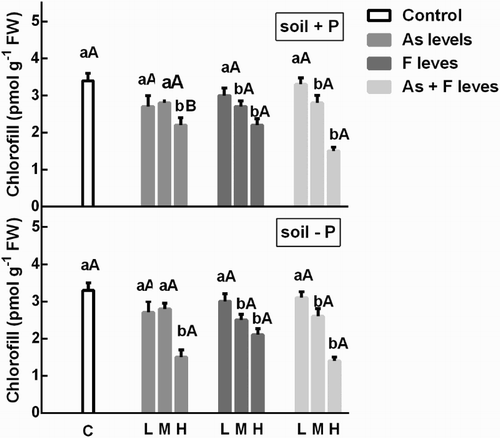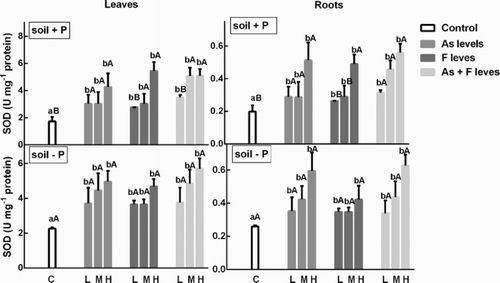Figures & data
Table 1. Factors, treatments and As and F concentrations.
Table 2. Determination of TBARS on soybean roots and leaves treated with low, medium and high As and/or F concentration with both P conditions.
Figure 1. Chlorophyll content on soybean leaves treatment with low, medium and high As and/or F concentration with both P conditions. Experiments were carried out as described in the ‘Materials and methods’ section. Data are mean values of three independent experiments ± S.E. Each value represents three replicates. Different lowercase letters within columns indicate significant differences with respect to controls (p < 0.05). Different capital letters within rows indicate significant differences between roots or leaves in Soil P+ and Soil P−(p < 0.05), according to the Tukey’s multiple range test.

Table 3. Glutathione content on soybean leaves treated with low, medium and high As and/or F concentration with both P conditions.
Figure 2. Determination of CAT activity on soybean roots and leaves’ treatment with low, medium and high As and/or F concentration with both P conditions. Experiments were carried out as described in the ‘Materials and methods’ section. Data are mean values of three independent experiments ± S.E. Each value represents three replicates. Different lowercase letters within columns indicate significant differences with respect to controls (p < 0.05). Different capital letters within rows indicate significant differences between roots or leaves in Soil P+ and Soil P−(p < 0.05), according to the Tukey’s multiple range test.

Figure 3. Determination of SOD activity on soybean roots and leaves’ treatment with low, medium and high As and/or F concentration with both P conditions. Experiments were carried out as described in the ‘Materials and methods’ section. Data are mean values of three independent experiments ± S.E. Each value represents three replicates. Different lowercase letters within columns indicate significant differences with respect to controls (p < 0.05). Different capital letters within rows indicate significant differences between roots or leaves in Soil P+ and Soil P−(p < 0.05), according to the Tukey’s multiple range test.

Figure 4. Determination of GPOX activity on soybean roots and leaves’ treatment with low, medium and high As and/or F concentration with both P conditions. Experiments were carried out as described in the ‘Materials and methods’ section. Data are mean values of three independent experiments ± S.E. Each value represents three replicates. Different lowercase letters within columns indicate significant differences with respect to controls (p < 0.05). Different capital letters within rows indicate significant differences between roots or leaves in Soil P+ and Soil P−(p < 0.05), according to the Tukey’s multiple range test.

